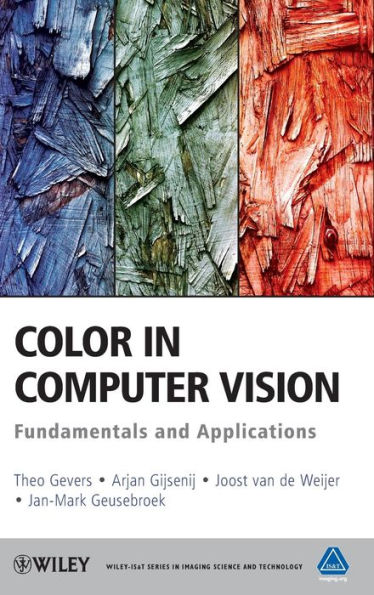Table of Contents
Preface xv
1 Introduction 1 1.1 From Fundamental to Applied 2 1.2 Part I: Color Fundamentals 3 1.3 Part II: Photometric Invariance 3 1.4 Part III: Color Constancy 4 1.5 Part IV: Color Feature Extraction 5 1.6 Part V: Applications 7 1.7 Summary 9
PART I Color Fundamentals 11
2 Color Vision 13 2.1 Introduction 13 2.2 Stages of Color Information Processing 14 2.3 Chromatic Properties of the Visual System 18 2.4 Summary 24
3 Color Image Formation 26 3.1 Lambertian Reflection Model 28 3.2 Dichromatic Reflection Model 29 3.3 Kubelka–Munk Model 32 3.4 The Diagonal Model 34 3.5 Color Spaces 36 3.6 Summary 44
PART II Photometric Invariance 47
4 Pixel-Based Photometric Invariance 49 4.1 Normalized Color Spaces 50 4.2 Opponent Color Spaces 52 4.3 The HSV Color Space 52 4.4 Composed Color Spaces 53 4.5 Noise Stability and Histogram Construction 58 4.6 Application: Color-Based Object Recognition 64 4.7 Summary 68
5 Photometric Invariance from Color Ratios 69 5.1 Illuminant Invariant Color Ratios 71 5.2 Illuminant Invariant Edge Detection 73 5.3 Blur-Robust and Color Constant Image Description 74 5.4 Application: Image Retrieval Based on Color Ratios 77 5.5 Summary 80
6 Derivative-Based Photometric Invariance 81 6.1 Full Photometric Invariants 84 6.2 Quasi-Invariants 101 6.3 Summary 111
7 Photometric Invariance by Machine Learning 113 7.1 Learning from Diversified Ensembles 114 7.2 Temporal Ensemble Learning 119 7.3 Learning Color Invariants for Region Detection 120 7.4 Experiments 124 7.5 Summary 134
PART III Color Constancy 135
8 Illuminant Estimation and Chromatic Adaptation 137 8.1 Illuminant Estimation 139 8.2 Chromatic Adaptation 141
9 Color Constancy Using Low-level Features 143 9.1 General Gray-World 143 9.2 Gray-Edge 146 9.3 Physics-Based Methods 150 9.4 Summary 151
10 Color Constancy Using Gamut-Based Methods 152 10.1 Gamut Mapping Using Derivative Structures 155 10.2 Combination of Gamut Mapping Algorithms 157 10.3 Summary 160
11 Color Constancy Using Machine Learning 161 11.1 Probabilistic Approaches 161 11.2 Combination Using Output Statistics 162 11.3 Combination Using Natural Image Statistics 163 11.4 Methods Using Semantic Information 167 11.5 Summary 171
12 Evaluation of Color Constancy Methods 172 12.1 Data Sets 172 12.2 Performance Measures 175 12.3 Experiments 180 12.4 Summary 185
PART IV Color Feature Extraction 187
13 Color Feature Detection 189 13.1 The Color Tensor 191 13.2 Color Saliency 205 13.3 Conclusions 218
14 Color Feature Description 221 14.1 Gaussian Derivative-Based Descriptors 225 14.2 Discriminative Power 229 14.3 Level of Invariance 235 14.4 Information Content 236 14.5 Summary 243
15 Color Image Segmentation 244 15.1 Color Gabor Filtering 245 15.2 Invariant Gabor Filters Under Lambertian Reflection 247 15.3 Color-Based Texture Segmentation 247 15.4 Material Recognition Using Invariant Anisotropic Filtering 249 15.5 Color Invariant Codebooks and Material-Specific Adaptation 256 15.6 Experiments 258 15.7 Image Segmentation by Delaunay Triangulation 263 15.8 Summary 268
PART V Applications 269
16 Object and Scene Recognition 271 16.1 Diagonal Model 272 16.2 Color SIFT Descriptors 273 16.3 Object and Scene Recognition 276 16.4 Results 280 16.5 Summary 285
17 Color Naming 287 17.1 Basic Color Terms 288 17.3 Color Names from Uncalibrated Data 304 17.4 Experimental Results 313 17.5 Conclusions 316
18 Segmentation of Multispectral Images 318 18.1 Reflection and Camera Models 319 18.2 Photometric Invariant Distance Measures 321 18.3 Error Propagation 325 18.4 Photometric Invariant Region Detection by Clustering 328 18.5 Experiments 330 18.6 Summary 338
Citation Guidelines 339
References 341
Index 363






